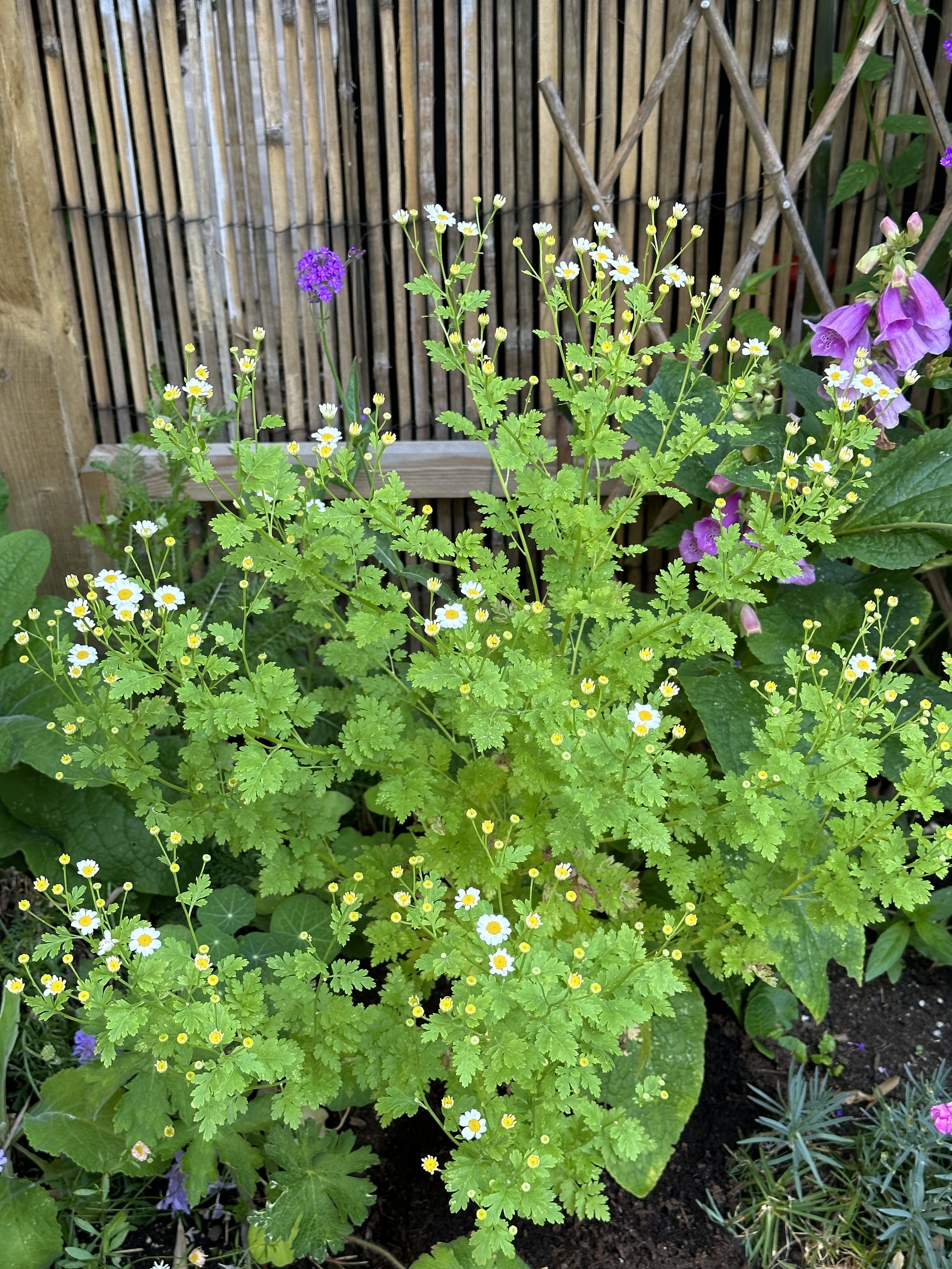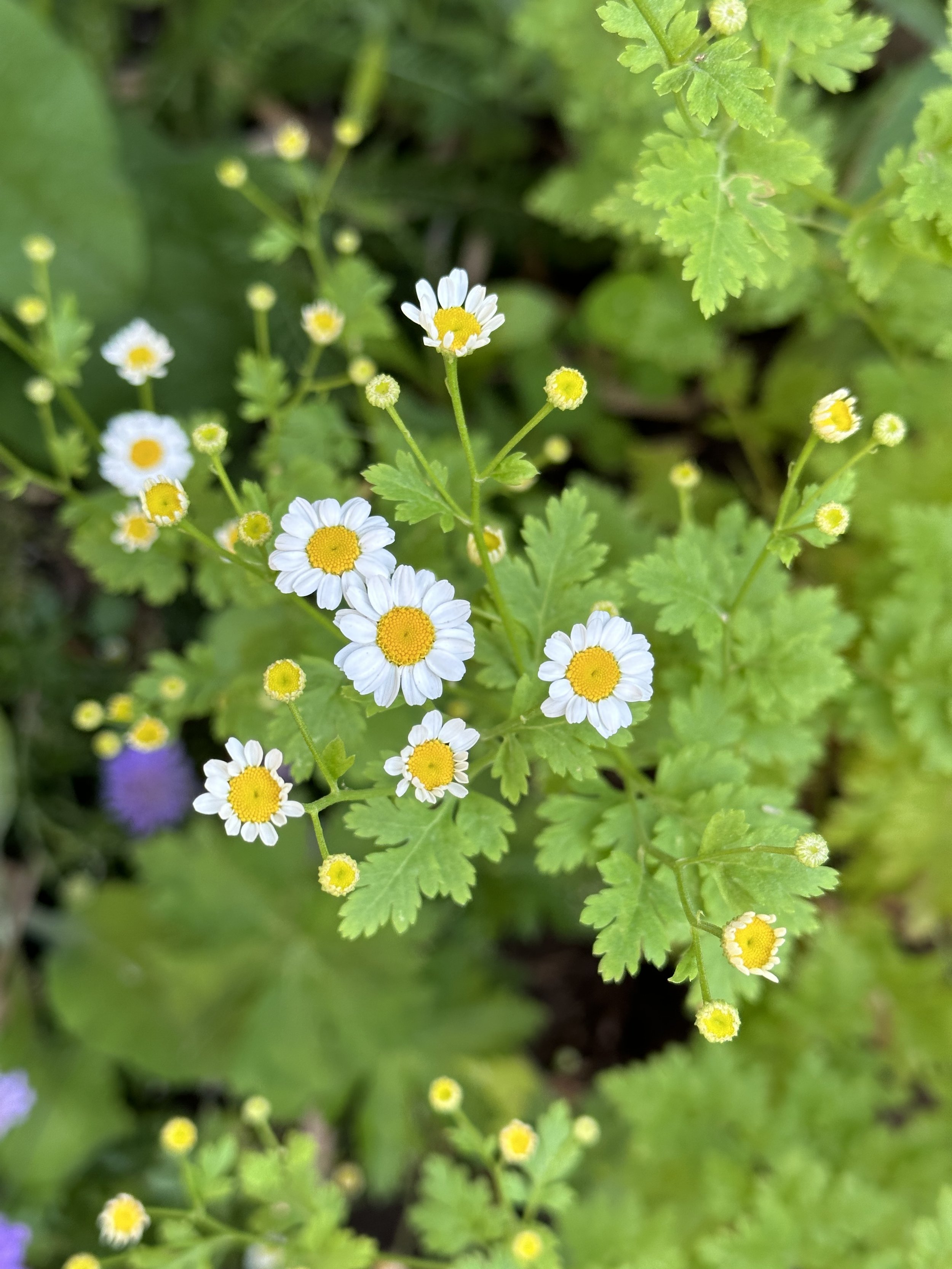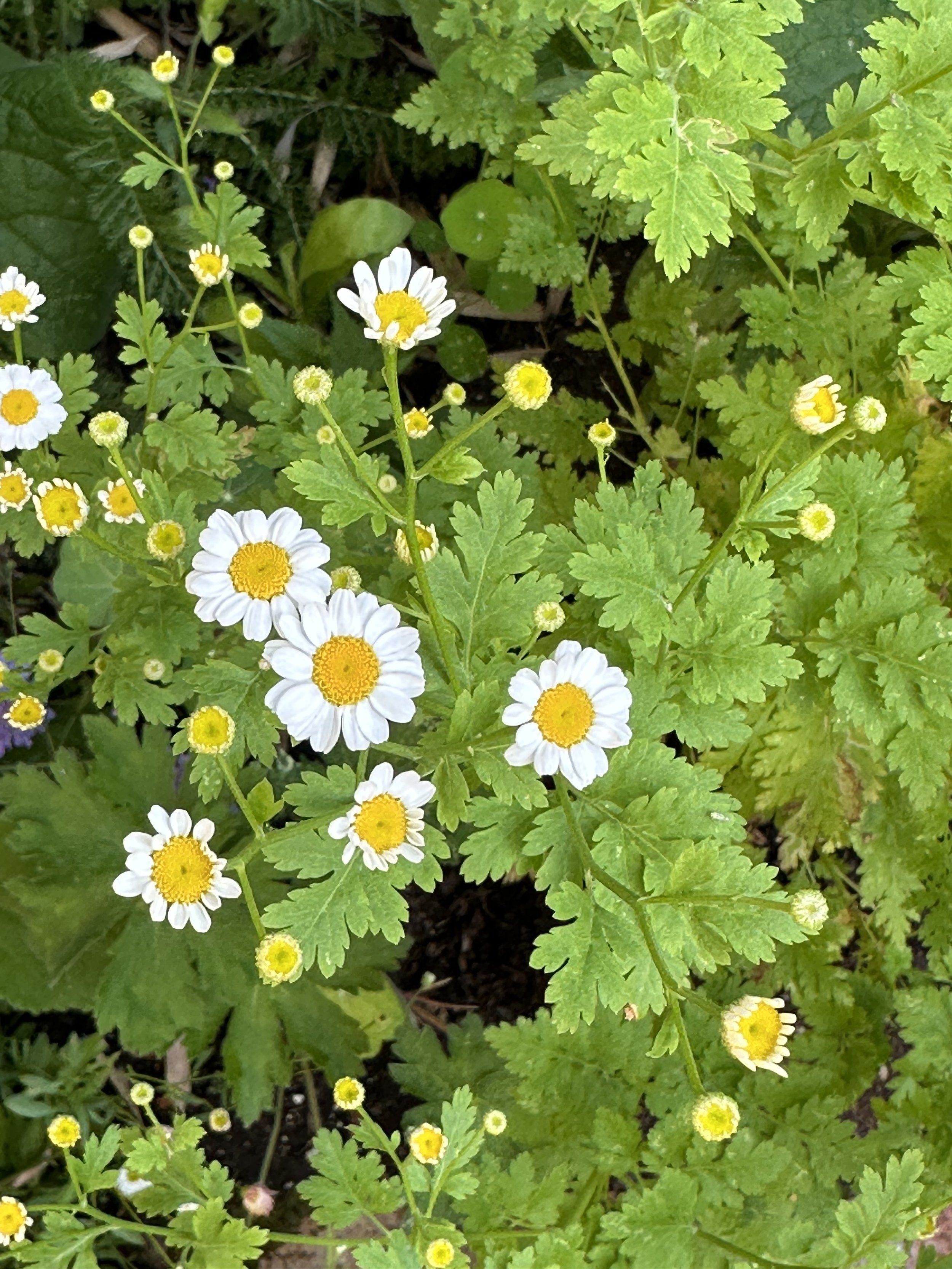Where to Plant Feverfew
This article has links to products that I may make commission from.
Feverfew, or Tanacetum parthenium (previously known as Chrysanthemum parthenium), is a revered herb in many gardens.
Loved for its daisy-like flowers with yellow centers, feverfew is a beautiful addition to any garden.
It also serves as a therapeutic herb used for centuries to treat various ailments.
So, where should you plant this versatile herb?
Let's delve into the world of growing feverfew and discover its best cultivation practices.
To learn more about herb gardening, check out my guides:
Starting Feverfew from Seeds
Growing feverfew is an exciting journey that begins with starting seeds indoors.
Initiating the process inside gives you a head-start, as you can regulate the conditions to suit these seedlings' needs.
Garden supplies like cell packs can be used to start seeds indoors before spring arrives.
This method also allows you to maintain your feverfew plants in their nascent stages, particularly during the colder months.
Preparation
Before you start, gather all your necessary supplies. You will need:
A clear plastic cover or bag
A heat mat (optional)
When to Plant Feverfew Seeds
Starting Indoors:
If you're starting your seeds indoors, begin about 6-8 weeks before the last expected spring frost.
Starting seeds indoors allows them to develop strong root systems and increases their chances of survival once they are transplanted outdoors.
Sowing Outdoors:
If you plan to sow the seeds directly into your garden, it's best to wait until after the danger of frost has passed and soil temperatures have warmed up.
In most regions, this typically means late spring or early summer.
Sowing the Seeds
Feverfew seeds need light to germinate, so do not bury them deep in the soil.
Fill your seed trays with the seed starting mix, then gently press two to three seeds into the surface of each cell or pot.
Make sure the seeds are slightly exposed to light.
After sowing, mist the seeds gently with water using a spray bottle.
You want the soil to be moist but not waterlogged.
Germination
To create a humid environment ideal for germination, cover the seed trays or peat pots with a clear plastic cover or bag.
Place them in a warm, well-lit spot. The top of a refrigerator or a heat mat can provide the warmth needed for germination.
Feverfew seeds usually germinate in 14 to 21 days, but they can sometimes take a little longer.
Be patient, and make sure the soil stays moist (but not wet) during this time.
Post-Germination Care
Once the seedlings emerge, remove the plastic covering and place the trays or pots in a sunny spot or under grow lights.
When the seedlings develop their first set of true leaves (these will be the second set of leaves you'll see), you can begin to thin them out.
Choose the strongest seedling in each cell or pot to keep, and remove the others.
Before you transplant the seedlings outdoors, they will need to be hardened off. This involves gradually acclimating them to outdoor conditions.
Start by placing them outside in a sheltered spot for a few hours each day, gradually increasing the time they spend outside over a week or two.
After the danger of frost has passed and the seedlings have been hardened off, they can be transplanted into the garden.
Choose a location with full sun and well-drained soil. Remember to keep an adequate space of around 8-12 inches between plants to accommodate their mature size.
Starting feverfew from seeds can be a rewarding process.
Not only will you enjoy the beautiful flowers and the medicinal properties of this plant, but you will also have the satisfaction of knowing that you grew them from seed.
Looking for more herb garden inspiration? Check out my guides:
Feverfew Growing Conditions
Feverfew Light Requirements
Feverfew thrives in full sun conditions, meaning it prefers a spot that receives at least 6-8 hours of direct sunlight each day.
This allows the plant to photosynthesize effectively and helps promote robust growth and abundant flowering.
However, while it does love the sun, feverfew can also tolerate partial shade, especially in regions where the afternoon sun can be particularly scorching.
Partial shade refers to areas that are exposed to direct sunlight for about 3-6 hours per day.
Feverfew would be perfect for a south east facing garden.
Soil Conditions
When it comes to soil, feverfew isn't too fussy but prefers well-drained soil for optimal growth.
The term "well-drained" means that water passes through the soil at a moderate rate, neither too quickly nor too slowly.
This balance prevents waterlogging, which can lead to root rot, and ensures that the plant's roots have access to the necessary moisture.
Feverfew's preferred soil type is loam, which is a balanced mixture of sand, silt, and clay.
Loamy soil offers several benefits for plant health: it retains moisture but drains well, it is nutrient-rich, and it is easy for plant roots to penetrate.
The pH level of the soil can also affect feverfew's growth.
The plant prefers a neutral to slightly alkaline pH, in the range of 6.0 to 7.5.
If you're unsure of your soil's pH, you can test it using a soil testing kit.
Here is the one I recommend using:
If you're growing feverfew in containers, ensure your potting mix is well-draining.
It's also essential to check that your chosen container has sufficient drainage holes to avoid water buildup.
Whether in the garden or a container, providing your feverfew plant with its preferred light and soil conditions will set it up for a successful, healthy life.
My favorite feverfew seeds:
To learn more about starting an herb garden, check out my guides:
Feverfew Height and Spread
How tall does feverfew grow, you ask? Well, a well-tended feverfew plant can reach a height of up to 2 feet and spread around 18 inches.
Its compact size makes it a great fit for container gardening or a mixed herb garden.
Feverfew Height
Feverfew typically reaches a height of about 18 inches to 24 inches (or 1.5 to 2 feet) when fully grown.
This can vary slightly based on specific growing conditions.
For example, in a location with full sun and well-drained soil, feverfew is likely to reach its maximum potential height.
Feverfew Spread
In terms of spread, feverfew usually expands to cover an area of approximately 18 inches to 24 inches.
This indicates the plant's width or the space it needs to grow without becoming crowded.
Keep in mind, while it doesn't have an extensive spread, feverfew can self-seed very efficiently.
If conditions are favorable and if the spent flowers aren't removed, the plant can naturalize and spread in your garden.
This self-seeding capability makes feverfew a lively addition to your garden, but also one that may need some control to prevent it from spreading more than desired.
Considerations for Planting
Given its height and spread, ensure to leave sufficient space between feverfew plants when you're adding them to your garden or a container.
If you're planting multiple feverfew plants together, space them about 15 to 18 inches apart to allow enough room for their full spread.
This spacing will enable the plants to get adequate sunlight and air circulation, which is essential for their health and growth.
Remember, taking the time to understand a plant's growth habits, such as its height and spread, will not only help you ensure it has the space to grow but also assist in maintaining the overall aesthetics and health of your garden.
To learn more about herb gardening, check out my guide:
Feverfew Planting and Growing Tips
Planting Feverfew
Starting Indoors:
Start your feverfew seeds indoors approximately 6-8 weeks before the last expected spring frost.
Remember to keep the seed tray in a warm location and ensure the seeds receive plenty of light.
Transplanting:
After the last frost and once your seedlings are robust enough (typically when they have at least two sets of true leaves), you can transplant them outdoors.
Harden off the seedlings for a week or so before transplanting to acclimate them to outdoor conditions.
Spacing:
When you're ready to plant, ensure each feverfew plant has enough space to grow.
Given their mature size, feverfew plants should be spaced about 8-12 inches apart.
This spacing promotes better air circulation and prevents overcrowding.
Growing Feverfew
Location:
Feverfew plants prefer a location in full sun to partial shade.
If you live in a hotter region, an area with afternoon shade can be beneficial.
Soil:
Feverfew thrives best in well-drained, loamy soil with a neutral to slightly alkaline pH.
Watering:
Regular watering is essential for feverfew, especially in dry conditions.
However, avoid waterlogging as this can lead to root problems.
The soil should be moist, not drenched.
For more watering tips, check out my guide How Often to Water Seedlings.
Fertilizing:
While feverfew isn't a heavy feeder, applying a balanced organic fertilizer can provide extra nutrients and boost the plant's health and growth.
This can be particularly beneficial if you're growing feverfew in a container, as nutrients in potting soil can deplete over time.
Maintenance:
Regularly check your plants for any signs of disease or pests.
Feverfew is generally low-maintenance and pest-resistant, but like any plant, it can occasionally experience issues.
Harvesting:
You can harvest feverfew leaves as needed throughout the growing season.
For medicinal purposes, it's best to harvest just before the plant flowers, when the concentration of the plant's active compounds is highest.
For more inspiration, check out my guide:
Harvest Feverfew and Its Companion Planting
Harvesting Feverfew
When harvesting feverfew, timing is important.
The best time to harvest feverfew is in the early morning, once the dew has evaporated but before the heat of the day.
This is when the plant's essential oils are most concentrated.
Feverfew leaves can be harvested at any time, but they are most potent just before the plant flowers.
You can cut off the stems with a sharp, clean pair of gardening shears, and then strip off the leaves.
The flowers, once fully open, can also be harvested for use.
To dry feverfew, hang the stems upside down in a dark, dry, and well-ventilated area.
Once dried, the leaves and flowers can be stored in an airtight container for future use.
Learn more about how to store dried herbs in my full guide:
Feverfew Companion Planting
Companion planting involves growing different plants close together for mutual benefit.
Feverfew, with its strong aromatic nature, can help deter pests such as aphids, and can thus be a beneficial companion plant for a variety of others.
Roses:
Feverfew can be planted near roses to help repel unwanted insects.
Additionally, the white blooms of feverfew can beautifully complement the vibrant colors of roses.
Delphiniums:
These plants are often plagued by aphids, and planting feverfew nearby can help deter these pests.
Tomatoes and Broccoli:
Feverfew may also benefit vegetables like tomatoes and broccoli by deterring pests that commonly affect these plants.
Remember, the key to successful companion planting lies in understanding the needs and habits of different plants, ensuring they're compatible, and can coexist without competing for resources.
A final tip: Feverfew can be a prolific self-seeder, so unless you want it to naturalize in your garden, consider removing spent flowers to prevent excessive self-sowing.
With these harvesting and companion planting tips, you'll be well-prepared to grow and enjoy feverfew in your garden.
FAQs
Is feverfew plant invasive?
While feverfew is not officially classified as an invasive plant, it can be quite a vigorous self-seeder.
If it's allowed to go to seed, it can spread beyond its intended area in your garden.
However, this can be easily managed by deadheading flowers before they have a chance to produce and distribute seeds.
Is feverfew plant edible?
Yes and no.
While feverfew is often used in herbal medicine, it's not typically consumed as a food.
The leaves and flowers can be used to make teas or extracts, and they are sometimes used in capsule or tablet form.
However, the plant has a strong, somewhat bitter taste that many people find unpalatable.
Furthermore, some people might have an allergic reaction to the plant, so it's important to proceed with caution and consult a healthcare professional before consuming feverfew.
Is feverfew a perennial?
Yes, feverfew is a perennial plant, which means it can live for several years, going dormant in the winter and returning in the spring.
However, in colder climates, it's often grown as an annual.
Does feverfew plant spread?
Yes, feverfew can spread in two main ways.
The first is by self-seeding, which can happen quite efficiently if the spent flowers are not removed.
The second way is through its root system. Feverfew can form a spreading clump as it matures, and this can be divided to create new plants.
For more tips, check out my guide:
To wrap-up, planting feverfew in your garden not only enhances your space's aesthetic appeal but also offers a host of potential health benefits.
As a perennial, feverfew can provide beauty and medicinal value year after year, becoming a reliable and cherished part of your garden's design.
The daisy-like white blooms with sunny yellow centers make a delightful addition to any herb garden or border, adding charm and contrast.
Not to forget, feverfew's capability to deter pests, making it a fantastic companion plant for various herbs and flowers.
Beyond its looks, the potency of this humble herb, especially its flowers, should not be underestimated.
However, remember that while gardening is an art, it's also a science.
The more you understand about a plant's requirements—such as when to plant feverfew seeds, light and soil preferences, its height, and spread—the more likely you are to succeed in growing it.
Additionally, knowing when and how to harvest feverfew can ensure that you reap the maximum potential benefits. So, whether you're an experienced gardener or just starting, consider adding feverfew to your planting plans.
Its inclusion will add a new dimension to your garden design, expanding your palette of herbs and bringing its unique advantages.
Buy my favorite feverfew seeds here:





































